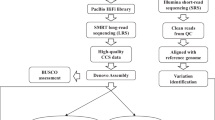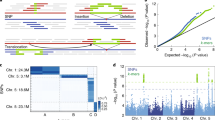Abstract
The majority of agronomic traits are controlled by multiple genes that cause minor phenotypic effects, making the identification of these genes difficult. Here we introduce MutMap, a method based on whole-genome resequencing of pooled DNA from a segregating population of plants that show a useful phenotype. In MutMap, a mutant is crossed directly to the original wild-type line and then selfed, allowing unequivocal segregation in second filial generation (F2) progeny of subtle phenotypic differences. This approach is particularly amenable to crop species because it minimizes the number of genetic crosses (n = 1 or 0) and mutant F2 progeny that are required. We applied MutMap to seven mutants of a Japanese elite rice cultivar and identified the unique genomic positions most probable to harbor mutations causing pale green leaves and semidwarfism, an agronomically relevant trait. These results show that MutMap can accelerate the genetic improvement of rice and other crop plants.
This is a preview of subscription content, access via your institution
Access options
Subscribe to this journal
Receive 12 print issues and online access
$209.00 per year
only $17.42 per issue
Buy this article
- Purchase on SpringerLink
- Instant access to full article PDF
Prices may be subject to local taxes which are calculated during checkout




Similar content being viewed by others
Accession codes
References
Godfray, H.C.J. et al. Food security: The challenge of feeding 9 billion people. Science 327, 812–818 (2010).
Tester, M. & Langridge, P. Breeding technologies to increase crop production in a changing world. Science 327, 818–822 (2010).
Baulcombe, D. Reaping benefits of crop research. Science 327, 761 (2010).
Falconer, D.S. & Mackay, T.F.C. Introduction to Quantitative Genetics (Pearson/Prentice Hall, 1996).
Rakshit, S. et al. Use of TILLING for reverse and forward gentics of rice. in The Handbook of Plant Mutation Screening: Mining of Natural and Induced Alleles. (eds. Meksem, K. & Kahl, G.) 187–198 (Wiley-VCH, 2010).
Li, H., Ruan, J. & Durbin, R. Mapping short DNA sequencing reads and calling variants using mapping quality scores. Genome Res. 18, 1851–1858 (2008).
Pienkowska, M., Glickman, B.W., Ferreira, A., Anderson, M. & Zielenska, M. Large-scale mutational analysis of EMS-induced mutation in the lacI gene of Escherichia coli. Mutat. Res. 288, 123–131 (1993).
Lee, S. et al. Differential regulation of chlorophyll a oxygenase genes in rice. Plant Mol. Biol. 57, 805–818 (2005).
Sasaki, A. et al. Green revolution: a mutant gibberellin-synthesis gene in rice. Nature 416, 701–702 (2002).
Schneeberger, K. et al. SHOREmap: simultaneous mapping and mutation identification by deep sequencing. Nat. Methods 6, 550–551 (2009).
Austin, R.S. et al. Next-generation mapping of Arabidopsis genes. Plant J. 67, 715–725 (2011).
Uchida, N., Sakamoto, T., Kurata, T. & Tasaka, M. Identification of EMS-induced causal mutations in a non-reference Arabidopsis thaliana accession by whole genome sequencing. Plant Cell Physiol. 52, 716–722 (2011).
Michelmore, R.W., Paran, I. & Kesseli, R.V. Identification of markers linked to disease-resistance genes by bulked segregant analysis: a rapid method to detect markers in specific genomic regions by using segregating populations. Proc. Natl. Acad. Sci. USA 88, 9828–9832 (1991).
Giovannoni, J.J. et al. Isolation of molecular markers from specific chromosomal intervals using DNA pools from existing mapping populations. Nucleic Acids Res. 19, 6553–6558 (1991).
Zuryn, S., Le Gras, S., Jamet, K. & Jarriault, S. A strategy for direct mapping and identification of mutations by whole-genome sequencing. Genetics 186, 427–430 (2010).
Ashelford, K. et al. Full genome re-sequencing reveals a novel circadian clock mutation in Arabidopsis. Genome Biol. 12, R28 (2011).
Robertson, D.S. A possible technique for isolating genic DNA for quantitative traits in plants. J. Theor. Biol. 117, 1–10 (1985).
International Rice Genome Sequencing Project. The map-based sequence of the rice genome. Nature 436, 793–800 (2005).
Li, H. et al. The Sequence Alignment/Map (SAM) format and SAMtools. Bioinformatics 25, 2078–2079 (2009).
Nakagawa, T. et al. Development of series of gateway binary vectors, pGWBs, for realizing efficient construction of fusion genes for plant transformation. J. Biosci. Bioeng. 104, 34–41 (2007).
Miki, D., Itoh, R. & Shimamoto, K. RNA silencing of single and multiple members in a gene family of rice. Plant Physiol. 138, 1903–1913 (2005).
Toki, S. et al. Early infection of scutellum tissue with Agrobacterium allows high-speed transformation of rice. Plant J. 47, 969–976 (2006).
Acknowledgements
This study was supported by the Program for Promotion of Basic Research Activities for Innovative Biosciences, to R.T., H.I. and A.A. Ministry of Agriculture, Forestry and Fisheries of Japan (Genomics for Agricultural Innovation PMI-0010), Ministry of Education, Culture, Sports, Science and Technology of Japan (Grant-in-Aid for Scientific Research on Innovative Areas 23113009) to R.T. and a Daiwa Adrian Prize to S. Kamoun and R.T. L.C. and S. Kamoun were supported by the Gatsby Charitable Foundation. We thank S. Kuroda for general support and M.J. Terry, B. Wulff and K. Tsunewaki for suggestions to improve the paper.
Author information
Authors and Affiliations
Contributions
A.A. conceived the idea and carried out rice crossing and phenotyping; S. Kosugi developed a bioinformatics pipeline to perform MutMap; K.Y., S.N. and L.C. carried out genome analysis; H.T. and K.Y. carried out rice transformation; H.K., H.M. and M.T. performed mutagenesis; C.M. carried out sequencing; H.I. performed theoretical analysis; S. Kamoun and R.T. conceived the idea, supervised the work and wrote the manuscript.
Corresponding author
Ethics declarations
Competing interests
The authors declare no competing financial interests.
Supplementary information
Supplementary Text and Figures
Supplementary Tables 1–7, Supplementary Data and Supplementary Figures 1–4 (PDF 5781 kb)
Rights and permissions
About this article
Cite this article
Abe, A., Kosugi, S., Yoshida, K. et al. Genome sequencing reveals agronomically important loci in rice using MutMap. Nat Biotechnol 30, 174–178 (2012). https://doi.org/10.1038/nbt.2095
Received:
Accepted:
Published:
Issue Date:
DOI: https://doi.org/10.1038/nbt.2095
This article is cited by
-
Mutation mapping of a variegated EMS tomato reveals an FtsH-like protein precursor potentially causing patches of four phenotype classes in the leaves with distinctive internal morphology
BMC Plant Biology (2024)
-
Visualizing plant intracellular inorganic orthophosphate distribution
Nature Plants (2024)
-
Temperature-dependent jumonji demethylase modulates flowering time by targeting H3K36me2/3 in Brassica rapa
Nature Communications (2024)
-
Aspartyl proteases identified as candidate genes of a fiber length QTL, qFLD05, that regulates fiber length in cotton (Gossypium hirsutum L.)
Theoretical and Applied Genetics (2024)
-
Identification of QTLs associated with very-long chain fatty acid (VLCFA) content via linkage mapping and BSA-seq in peanut
Theoretical and Applied Genetics (2024)



